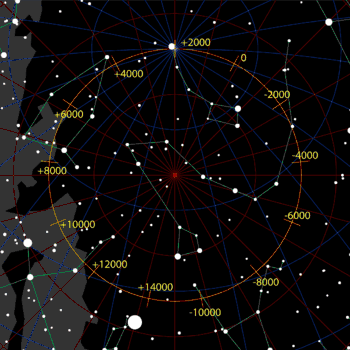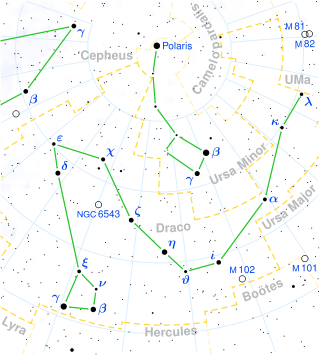Thuban
| Observation data Epoch J2000 Equinox J2000 | |
|---|---|
| Constellation | Draco |
| Right ascension | 14h 04m 23.3498s |
| Declination | 64° 22′ 33.062″ |
| Apparent magnitude (V) | 3.6452 |
| Characteristics | |
| Spectral type | A0III |
| U−B color index | -0.08 |
| B−V color index | -0.04 |
| Variable type | suspected Maia[1] |
| Astrometry | |
| Radial velocity (Rv) | -13.0 km/s |
| Proper motion (μ) | RA: -56.34 mas/yr Dec.: 17.21 mas/yr |
| Parallax (π) | 10.76 ± 0.17 mas |
| Distance | 303 ± 5 ly (93 ± 1 pc) |
| Absolute magnitude (MV) | −1.20[2] |
| Orbit | |
| Period (P) | 51.4167 days[3] |
| Semi-major axis (a) | 0.46 AU[1] |
| Eccentricity (e) | 0.4355 ± 0.0042[3] |
| Inclination (i) | 90[1]° |
| Semi-amplitude (K1) (primary) | 47.9340 ± 0.2990[3] km/s |
| Details | |
| α Dra A | |
| Mass | 2.8[1] M☉ |
| Radius | 3.4[4] R☉ |
| Luminosity | 479[5] L☉ |
| Surface gravity (log g) | 3.5[6] cgs |
| Temperature | 10,100[5] K |
| Metallicity | −0.20[6] |
| Rotation | 26.2[6] |
| α Dra B | |
| Mass | 2.6[3] M☉ |
| Luminosity | 40[3] L☉ |
| Other designations | |
| Database references | |
| SIMBAD | data |
Thuban, also designated Alpha Draconis (α Draconis, abbreviated Alpha Dra, α Dra), is a star (or star system) in the constellation of Draco. A relatively inconspicuous star in the night sky of the Northern Hemisphere, it is historically significant as having been the north pole star from the 4th to 2nd millennium BC.
Even though Johann Bayer gave Thuban the designation Alpha, its apparent magnitude of 3.65 means it is 3.7 times fainter than the brightest star in the constellation, Gamma Draconis (Eltanin), whose apparent magnitude is 2.24.
Nomenclature
α Draconis (Latinised to Alpha Draconis) is the star's Bayer designation.
The traditional name Thuban is derived from the Arabic word ثعبان thuʿbān, 'snake'. It is sometimes known as the Dragon's Tail and as Adib. In 2016, the International Astronomical Union organized a Working Group on Star Names (WGSN)[7] to catalog and standardize proper names for stars. The WGSN's first bulletin of July 2016[8] included a table of the first two batches of names approved by the WGSN; which included Thuban for this star. It is now so entered in the IAU Catalog of Star Names.[9]
In Chinese, 紫微右垣 (Zǐ Wēi Yòu Yuán), meaning Right Wall of Purple Forbidden Enclosure, refers to an asterism consisting of Alpha Draconis, Kappa Draconis, Lambda Draconis, 24 Ursae Majoris, 43 Camelopardalis, Alpha Camelopardalis and BK Camelopardalis.[10] Consequently, Alpha Draconis itself is known as 紫微右垣一 (Zǐ Wēi Yòu Yuán yī, English: the First Star of Right Wall of Purple Forbidden Enclosure.),[11] representing 右樞 (Yòushū), meaning Right Pivot.[12] 右樞 (Yòushū) is westernized into Yu Choo by R.H. Allen with the same meaning.[13]
Visibility
Given good viewing conditions, Thuban is relatively easy to spot in the night sky, due to its location in relation to the Big Dipper (aka the Plough) asterism of Ursa Major. While it is well known that the two outer stars of the 'dipper' point to the modern-day pole star Polaris, it is less well known that the two inner stars, Phecda and Megrez, point to Thuban, just 15 degrees of arc from Megrez. Thuban is not bright enough to be viewed from badly light-polluted areas.
Pole star

Due to the precession of Earth's rotational axis, Thuban was the naked-eye star closest to the north pole from 3942 BC, when it superseded Iota Draconis as the Pole Star, until 1793 BC, when it was superseded by Kappa Draconis. It was closest to the pole in 2830 BC, when it was less than ten arc-minutes away from the pole.[14] It remained within one degree of celestial north for nearly 200 years afterwards, and even 900 years after its closest approach, was just five degrees off the pole. Thuban was considered the pole star until about 1800 BC, when the much brighter Beta Ursae Minoris (Kochab) began to approach the pole as well.
Having gradually drifted away from the pole over the last 4,800 years, Thuban is now seen in the night sky at a declination of 64° 20' 45.6", RA 14h 04m 33.58s. After moving nearly 47 degrees off the pole by 10000 AD, Thuban will gradually move back toward the north celestial pole. In 20346 AD, it will again be the pole star, that year reaching a maximum declination of 88° 43′ 17.3″, at right ascension 19h 08m 54.17s.
| Preceded by | Pole Star | Succeeded by |
|---|---|---|
| Iota Draconis | c. 3900–1800 BCE | Kochab |
Binary system
Thuban is a single-lined spectroscopic binary. Only the primary star can be detected in the spectrum. The radial velocity variations of the primary can be measured and the pair have a somewhat eccentric orbit of 51.4 days. Making some assumptions based on the faintness of the secondary, the stars are likely to be about 0.46 astronomical units apart and the secondary is a little less massive than the primary.[1] The secondary is likely to be a main sequence star slightly cooler than the primary, possibly an A2 spectral class.[3]
The secondary star was detected in high spatial resolution observations using the Navy Precision Optical Interferometer. The secondary star is 1.8 magnitudes (at 700 nm) fainter than the primary star and was detected at separations ranging from 6.2 to 2.6 milli-arcseconds.[15]
Properties
Thuban has a spectral class of A0III, indicating its similarity to Vega in temperature and spectrum, but more luminous and more massive. It has been used as an MK spectral standard for the A0III type.[16]
Thuban is not a main sequence star; it has now ceased hydrogen fusion in its core. That makes it a white giant star, being 120 times more luminous than the Sun. It is 300 light years away and its brightness is only decreased by 0.003 magnitudes by intervening gas and dust.[2]
Popular culture
The United States Navy ship USS Thuban (AKA-19) was built in 1943 and decommissioned in 1967.
Thuban has featured in works of fiction.
According to British conspiracy theorist David Icke, Alpha Draconis is the origin of blood-drinking, shape-shifting reptilians who lurk in underground bases and plot against humanity (with the aid of powerful figures such as Queen Elizabeth II).[17]
References
- 1 2 3 4 5 Kallinger, T.; Iliev, I.; Lehmann, H.; Weiss, W. W. (2005). "The puzzling Maia candidate star α Draconis". Proceedings of the International Astronomical Union. 2004: 848. Bibcode:2004IAUS..224..848K. doi:10.1017/S1743921305009865.
- 1 2 Murphy, Simon J.; Paunzen, Ernst (2017). "Gaia's view of the λ Boo star puzzle". Monthly Notices of the Royal Astronomical Society. 466: 546. arXiv:1612.01528. Bibcode:2017MNRAS.466..546M. doi:10.1093/mnras/stw3141.
- 1 2 3 4 5 6 Behr, Bradford B.; Hajian, Arsen R.; Cenko, Andrew T.; Murison, Marc; McMillan, Robert S.; Hindsley, Robert; Meade, Jeff (2009). "Stellar Astrophysics with a Dispersed Fourier Transform Spectrograph. I. Instrument Description and Orbits of Single-lined Spectroscopic Binaries". The Astrophysical Journal. 705: 543. arXiv:0909.3241. Bibcode:2009ApJ...705..543B. doi:10.1088/0004-637X/705/1/543.
- ↑ Wesselink, A. J.; Paranya, K.; Devorkin, K. (1972). "Catalogue of stellar dimensions". Astronomy and Astrophysics Supplement. 7: 257. Bibcode:1972A&AS....7..257W.
- 1 2 Balona, L. A.; Engelbrecht, C. A.; Joshi, Y. C.; Joshi, S.; Sharma, K.; Semenko, E.; Pandey, G.; Chakradhari, N. K.; Mkrtichian, David; Hema, B. P.; Nemec, J. M. (2016). "The hot γ Doradus and Maia stars". Monthly Notices of the Royal Astronomical Society. 460 (2): 1318. arXiv:1606.06426. Bibcode:2016MNRAS.460.1318B. doi:10.1093/mnras/stw1038.
- 1 2 3 Gray, David F. (2014). "Precise Rotation Rates for Five Slowly Rotating a Stars". The Astronomical Journal. 147 (4): 81. Bibcode:2014AJ....147...81G. doi:10.1088/0004-6256/147/4/81.
- ↑ "IAU Working Group on Star Names (WGSN)". Retrieved 22 May 2016.
- ↑ "Bulletin of the IAU Working Group on Star Names, No. 1" (PDF). Retrieved 28 July 2016.
- ↑ "IAU Catalog of Star Names". Retrieved 28 July 2016.
- ↑ (in Chinese) 中國星座神話, written by 陳久金. Published by 台灣書房出版有限公司, 2005, ISBN 978-986-7332-25-7.
- ↑ (in Chinese) 香港太空館 - 研究資源 - 亮星中英對照表 Archived 2010-08-19 at the Wayback Machine., Hong Kong Space Museum. Retrieved 2010-11-23.
- ↑ (in Chinese) English-Chinese Glossary of Chinese Star Regions, Asterisms and Star Name Archived 2010-08-10 at the Wayback Machine., Hong Kong Space Museum. Retrieved 2010-11-23.
- ↑ Richard Hinckley Allen (1963). "Star Names: Their Lore and Meaning". Dover Publications. p. 210. Retrieved 2010-12-17.
- ↑ Moore, Patrick (2005). "The Observer's Year: 366 Nights in the Universe". p. 283. Missing or empty
|url=(help) - ↑ Hutter, D. J.; Zavala, R. T.; Tycner, C.; Benson, J. A.; Hummel, C. A.; Sanborn, J.; Franz, O. G.; Johnston, K. J. (2016-11-01). "Surveying the Bright Stars by Optical Interferometry. I. A Search for Multiplicity among Stars of Spectral Types F-K". The Astrophysical Journal Supplement Series. 227: 4. arXiv:1609.05254. Bibcode:2016ApJS..227....4H. doi:10.3847/0067-0049/227/1/4. ISSN 0067-0049.
- ↑ Morgan, W. W.; Abt, Helmut A.; Tapscott, J. W. (1978). "Revised MK Spectral Atlas for stars earlier than the sun". Williams Bay: Yerkes Observatory. Bibcode:1978rmsa.book.....M.
- ↑ Hockney, Mike (2013). All The Rest is Propaganda. Hyperreality Books. p. 161. Retrieved September 13, 2017.
External links
- Jim Kaler's Stars, University of Illinois: THUBAN (Alpha Draconis)
- NASA's: History of Precession
- Crystalinks: Precession of the Equinoxes
